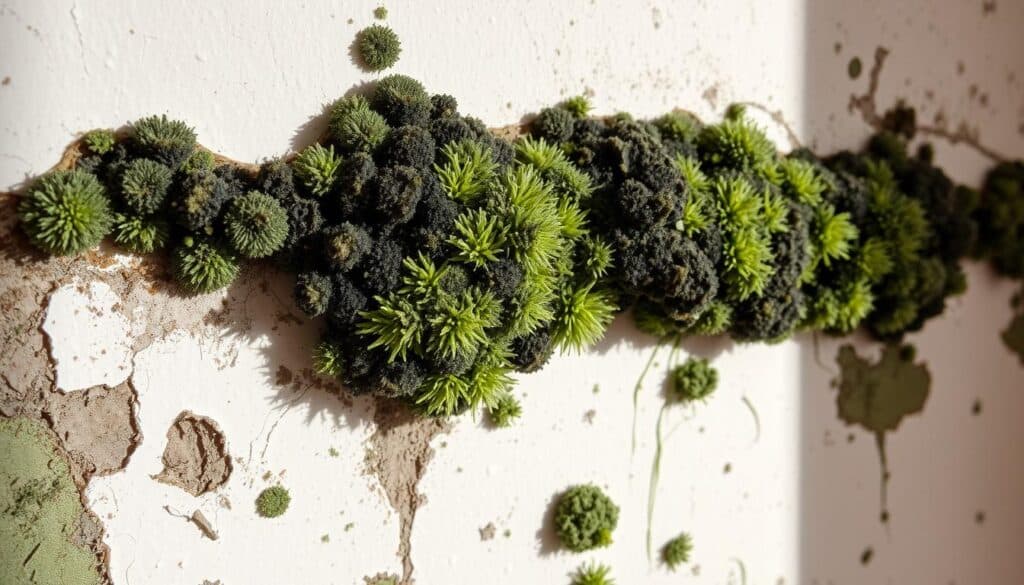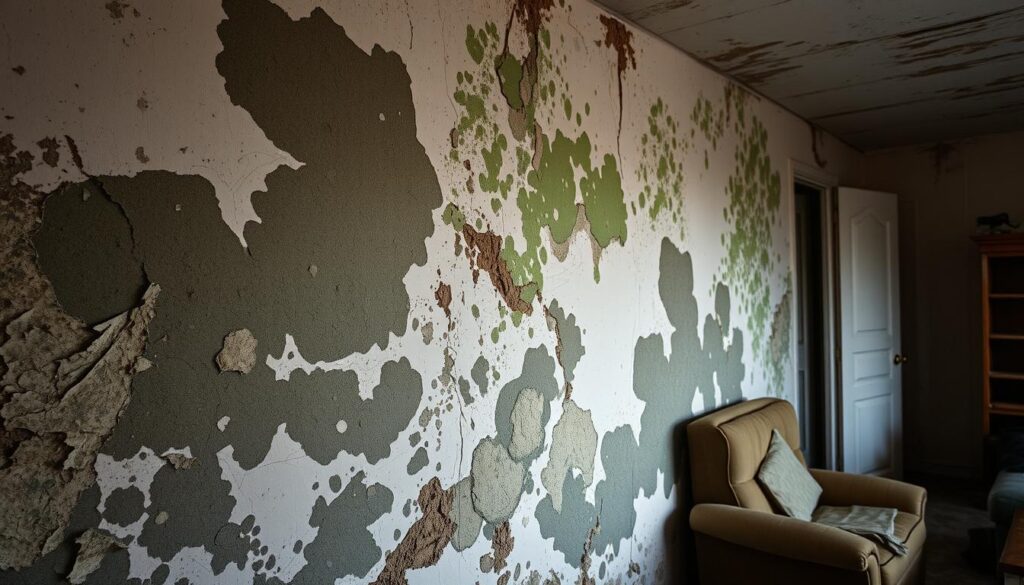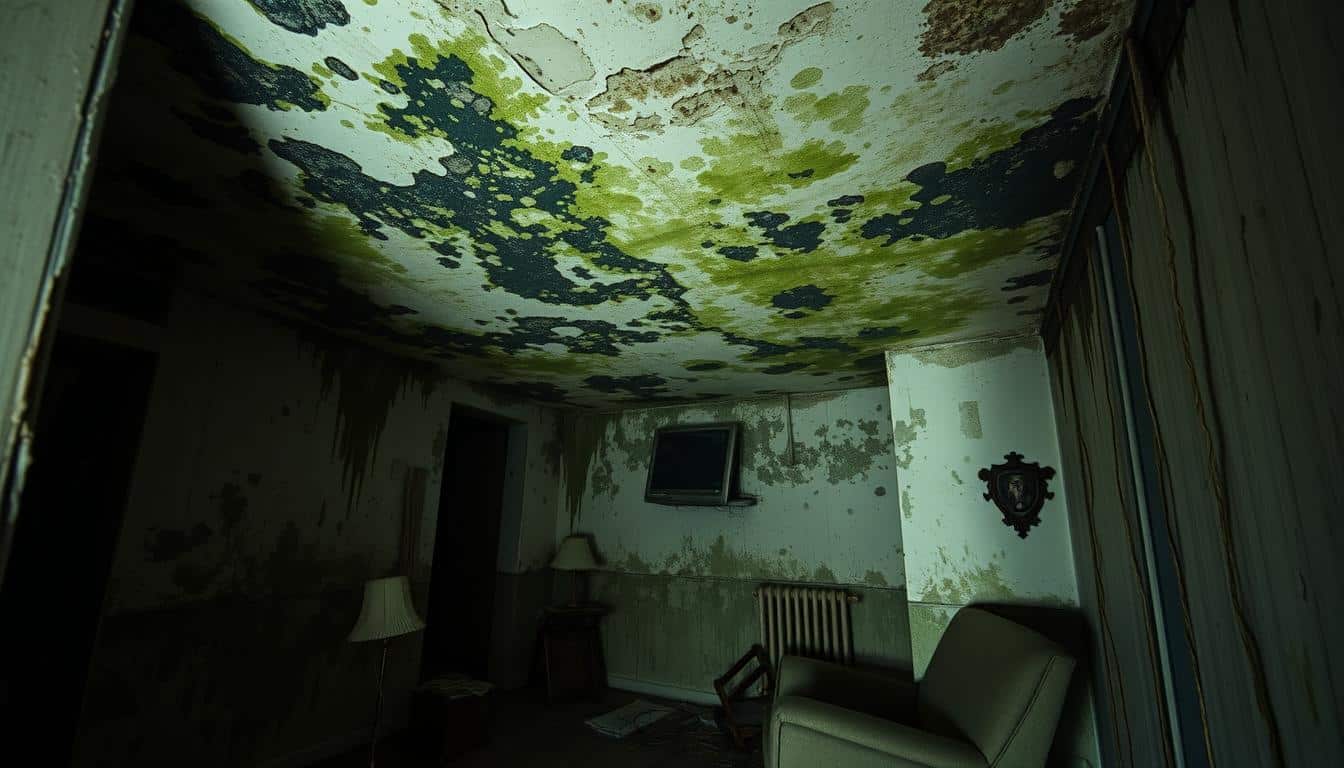Did you know over 25 years of experience in mold services in New York City? Mold can damage buildings and harm health. As a tenant, knowing how to test for mold is key to solving the problem early.
In this guide, I’ll show you how to find mold in your rental. We’ll cover how to tell mold from dirt and find moisture sources. You’ll also learn how to ask your landlord to fix it. By the end, you’ll know how to keep your home mold-free.
Key Takeaways:
- Mold can lead to serious health issues and structural damage in apartments.
- Tenants have the right to expect a mold-free apartment when moving in.
- A simple bleach-water test can help identify the presence of mold.
- Addressing the source of moisture is crucial to preventing mold growth.
- Contacting the landlord is an important step in addressing mold issues.
Distinguishing Mold from Dirt
Identifying mold in your apartment starts with knowing the difference between mold and dirt. Mold can look like dirt, especially when it’s just starting as mildew. To figure out if it’s mold or dirt, try a simple bleach test.
Using the Bleach Test
Mix one part bleach with 16 parts water. Then, use a cotton swab to apply it to the area. If it lightens a lot, it’s likely mold. Mold spores are everywhere, needing only moisture and the right temperature to grow.
Mildew starts as small black spots and can grow big. While home tests are not always reliable, the bleach test can help spot mold early.
| Mold Type | Appearance | Health Risks |
|---|---|---|
| Alternaria | Spread through airborne spores, olive green to black with a velvety texture | Allergic reactions, asthma |
| Cladosporium | Olive green to black, velvety texture | Respiratory issues, skin rashes |
| Penicillium | Green or blue, fuzzy texture | Sinus infections, lung inflammation, hay fever-like symptoms |
| Cryptococcus neoformans | Creamy to light brown, yeasty texture | Cryptococcal meningitis |
Knowing the difference between mold and dirt is the first step in checking for mold in your apartment. This helps you tackle any mold problems you might have.
Inspecting for Structural Damage
After finding mold, it’s important to see how much damage it has done. Mold that goes beyond mildew can start to rot your apartment’s structure. To check, use a sharp object like a screwdriver to poke the affected area. If the wall or wood feels soft or crumbly, it’s a clear sign of mold damage that needs fixing.
Poking Surfaces with a Sharp Object
To check for mold damage in your apartment, use a sharp object like a screwdriver. Gently poke the affected surfaces. If they feel soft, spongy, or crumbly, it means the mold has damaged the structure. This shows you need professional help to fix it and stop more damage.
| Mold Growth Stage | Structural Impact |
|---|---|
| Mildew | Surface-level growth, minimal damage |
| Advanced Mold | Penetrates and rots structural materials, significant damage |
Finding mold early is crucial to avoid expensive repairs and keep your rental property safe. By acting fast on mold in rental property, you can reduce risks and keep a healthy living space.
Early mold detection through inspection can save thousands of dollars, preventing costly remediation once the mold spreads throughout a home.
Identifying Moisture Sources
Mold needs moisture to grow, so finding and fixing moisture sources is key. Look first at your bathroom and kitchen. Leaks in these areas can make mold thrive.
Checking for Leaky Pipes
Begin by checking your plumbing for leaks. Run the water to spot drips or leaks. Moisture can spread, so check for mold in unexpected places. Fixing leaks is vital to stop mold in your rental.
- Check all faucets, showerheads, and pipes for any signs of dripping or leakage
- Inspect under sinks and around appliances for any water accumulation or damage
- Look for discoloration, stains, or mold growth that could indicate a hidden moisture problem
By identifying and addressing sources of moisture, you can control mold and keep your apartment healthy.
| Moisture Source | Potential Mold Growth | Health Risks |
|---|---|---|
| Leaky pipes | Behind walls, under sinks, in crawl spaces | Respiratory issues, allergic reactions |
| High humidity levels | On walls, ceilings, and surfaces | Asthma, skin irritation, sinus infections |
| Water damage from storms or leaks | Widespread growth in affected areas | Respiratory problems, immune system issues |
Visual Inspection for Mold Growth
Checking your apartment for signs of mold is key. As an apartment dweller, spotting mold growth early is crucial. It helps stop it from spreading and causing damage. Here are some tips to help you find apartment mold:
- Look for discoloration, staining, or textural changes on walls, ceilings, moldings, and other surfaces. Mold can appear slimy, fuzzy, or powdery.
- Check hard-to-reach areas like behind wallpaper, inside vents, and in attics or basements where mold testing apartment may be necessary.
- Pay attention to any persistent musty or earthy odors, as these can be indicators of detecting mold in your apartment.
Mold can grow and spread quickly, within 24 to 48 hours if not treated. Catching it early is vital. It helps avoid bigger apartment mold inspection and health problems for you and your family.
“On average, humans spend 90% of their time indoors where mold growth is a common occurrence.”
By doing a detailed visual check and watching for mold signs, you can act fast. This keeps your apartment healthy and safe for everyone.

how to test for mold in apartment
Mold can be a big problem in apartments, damaging property and health. Knowing how to test for mold is key to a safe home. Follow these steps to find and fix mold issues.
Distinguishing Mold from Dirt
First, tell mold from dirt. A bleach test can show if it’s mold. Apply bleach to the area. If it lightens, it’s mold. If not, it’s dirt.
Inspecting for Structural Damage
Look for damage that might cause mold. Use a screwdriver to check for soft spots in walls or wood. These signs mean water damage and mold.
Identifying Moisture Sources
Mold needs moisture to grow. Find and fix any water leaks. Check pipes, windows, and areas around sinks and tubs for leaks.
Conducting a Visual Inspection
Do a detailed look for mold. Check corners, behind furniture, and hard-to-reach spots. If you see mold, act fast.
By following these steps, you can find and fix mold in your apartment. Quick action is key to a healthy home.
| Mold Inspection Cost | What’s Included |
|---|---|
| $400 – $900 |
|
| $1,000 – $3,000+ |
|
“Mold can cause serious health issues, especially for those with allergies or respiratory conditions. It’s important to address any mold problems promptly to maintain a safe living environment.”
If you think you have mold, call a professional. They can check and fix the problem. This keeps you and your home safe.
Acting on Mold Findings
If you find mold in your apartment, act fast. As a renter, tell your landlord right away. They must fix mold issues to keep your living space safe and healthy.
Contacting the Landlord
When you talk to your landlord about mold, be clear and quick. Tell them where and how much mold there is. Also, mention the health risks mold can cause. Mold can grow fast, so quick action is key to avoid more damage and health problems.
The landlord might need to call in mold experts to clean and treat the area. Mold can spread in 24 to 48 hours if not treated, posing health risks. Health issues from mold include breathing problems, allergies, skin issues, headaches, tiredness, and asthma attacks.
If the landlord doesn’t fix the mold problem quickly, you might need to go to court. Mold and water damage from neglect or poor upkeep are legal issues. In Newport Beach, lawsuits have been filed against landlords for ignoring mold, causing health issues for tenants.
Keep talking openly and document everything about the mold issue. Working with your landlord quickly can help keep your living space safe and healthy.

Preventing Mold in Rentals
Keeping your rental property mold-free is key for a healthy home. As a renter, you can take steps to stop mold before it starts. Watch out for moisture and act fast to keep your place mold-free and healthy.
Fixing moisture problems quickly is a top way to stop mold. If you see leaks or water damage, tell your landlord fast. Waiting can lead to mold, which is hard and expensive to get rid of.
Good air flow is also vital. Use exhaust fans in the kitchen and bathroom. Open windows when you can to let air in. This helps keep moisture down and mold away.
- Check your rental often for mold, especially in wet areas like bathrooms and kitchens.
- Report any leaks or water damage right away to your landlord. Quick action stops mold.
- Make sure your apartment has enough air flow to keep humidity low.
- Keep your rental clean and dry to stop mold from growing.
- Think about using a dehumidifier in wet spots to control humidity.
By following these steps, you can lower the chance of mold in your rental. Remember, stopping mold early is the best way to keep your home healthy. Quick action on moisture issues can save you a lot of trouble later.
| Mold Prevention Tips for Renters | Landlord Responsibilities |
|---|---|
|
|
Stopping mold in your rental is a team effort between you and your landlord. By working together and fixing moisture problems fast, you can have a healthy, mold-free home.
“Mold can have serious health consequences, so it’s crucial to take proactive steps to prevent it in your rental property. Addressing moisture issues quickly and maintaining good ventilation are key to keeping your home mold-free.”
Mold Inspection and Remediation Services
If mold in your apartment is over 10 square feet, get a licensed mold inspector to help. They can find out what kind of mold you have and how much. They also figure out why it’s there and how to get rid of it safely.
A mold assessment by a pro can give you important advice. It helps you know how to fix the problem and stop it from coming back.
Professional Mold Assessment
The cost for a mold inspection varies. For houses under 4,000 square feet, it’s $300 to $400. Houses bigger than that cost $700 to $900.
Some mold remediation companies offer free inspections. They hope to get the job to fix the mold.
| Mold Testing Service | Average Cost |
|---|---|
| Swab Tests | $180 to $320 |
| Air Tests | $240 to $360 (up to $700 for advanced tests) |
| HVAC System Testing | $50 to $80 |
| Stain Testing | $100 to $160 |
| Mold Culture Tests | Around $50 |
When picking a mold inspector, look for someone experienced. They should know about both inspecting and fixing mold. This ensures they do the job right.
“Mold can be harmful and costly to remediate if left unaddressed, making the cost of a mold inspection a worthwhile investment in preventing extensive mold contamination.”
Conclusion
Testing for mold in your apartment is key to a healthy home. Follow the steps in this guide to spot and fix mold problems. This includes knowing the difference between mold and dirt and finding moisture sources.
Don’t wait to act. Quick action stops mold damage and health issues. With the right steps, you can keep your rental mold-free.
Being proactive is the best way to fight mold in your apartment. Check for moisture and mold often. Act fast when you find any.
Knowing how to test for mold and working with your landlord is important. This way, you can live in a safe, mold-free space.
To keep your apartment mold-free, stay alert and know what to do. Follow this guide to protect your home and health from mold. Work with your landlord to ensure your rental is safe and healthy.
FAQ
What is the first step in testing for mold in an apartment?
First, learn to tell mold from dirt. Mold looks like dirt at first. Use a bleach test to check if it’s mold.
How do you perform the bleach test to identify mold?
Mix one part bleach with 16 parts water. Dab it on the area with a cotton swab. If it lightens, it’s mold.
How can you check for structural damage caused by mold?
Use a screwdriver to gently poke the area. If it feels soft or crumbly, mold has damaged the structure.
What are some common sources of moisture that can lead to mold growth in an apartment?
Mold needs moisture to grow. Check your bathroom and kitchen for leaks. Look for mold signs away from the source too.
What should you look for during a visual inspection for mold in your apartment?
Look for discoloration, stains, or texture changes. Mold can be slimy, fuzzy, or powdery. Check hidden spots like behind wallpaper and in vents.
What should you do if you confirm the presence of mold in your apartment?
If you find mold, act fast. Tell your landlord, as they must fix it. They might need to call professionals for cleaning.
What can you do as a renter to prevent mold growth in your apartment?
To prevent mold, keep air flowing and fix moisture issues quickly. Check for mold signs often. Tell your landlord about leaks or water damage.
When should you consider hiring a professional mold assessment and remediation service?
Hire a mold expert for big problems over 10 square feet. They can find and fix the mold safely and effectively.




